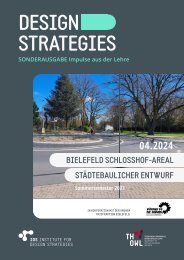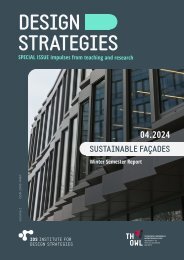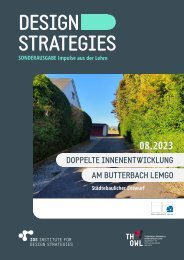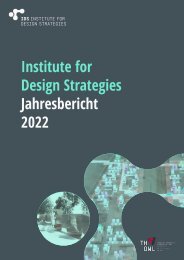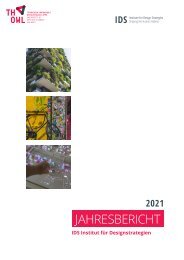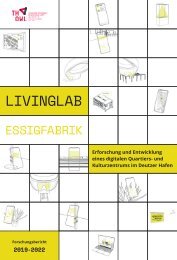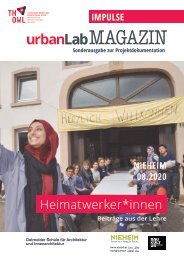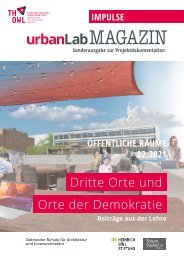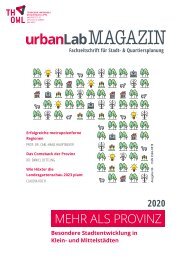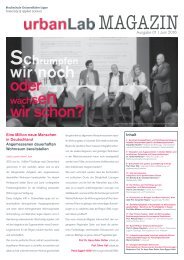urbanLab Magazin 2021 - Transformation
Sie wollen auch ein ePaper? Erhöhen Sie die Reichweite Ihrer Titel.
YUMPU macht aus Druck-PDFs automatisch weboptimierte ePaper, die Google liebt.
virtual reality to allow spatial experience.<br />
Visual models produced by rapid<br />
prototyping have the power to explain<br />
the aesthetical impact of complex façade<br />
details. Moreover, another kind of<br />
digitization in this early planning stage<br />
is the digital platforms for product research<br />
and comparison.<br />
SYSTEM DEVELOPMENT STAGE<br />
Fig. 2: Finite element analysis assists with a prediction of the<br />
structural behavior in the early planning stage<br />
In this phase, the detail development of<br />
the façade takes place. Metal workers,<br />
cladding companies and system supplier<br />
fine-tune the façade for its final<br />
performance. A holistic detail design<br />
that considers the complete façade life-cycle<br />
is very important, as it influences<br />
its fabrication, installation and the<br />
recycling potential of the façade. When<br />
a new product is designed, it is essential<br />
to check if the performance criteria<br />
(e.g. wind and water tightness, security<br />
issues) are met. These tests were<br />
mainly executed after completion of<br />
the detail development process, with<br />
physical mockups in the test laboratory.<br />
If the new developed product failed<br />
in one of those tests, an alteration of<br />
the product could be very time-consuming<br />
and costly. Nowadays, modern<br />
digital simulation methods provide the<br />
possibility to run preliminary tests that<br />
allow for a performance check and fine-tuning<br />
of the system in the ongoing<br />
product development. Finite element<br />
tools for example assist to analyze<br />
the façade according to thermal and<br />
acoustical properties and its structural<br />
behavior (Figure 2).<br />
Thanks to these tools it is possible to<br />
make predictions regarding the façade<br />
performance in aspects like wind and<br />
air tightness, punctual structural impacts<br />
from flying parts as well as effects<br />
of seismic activities (Arztmann, 2018).<br />
The change to three-dimensional construction<br />
drawings in addition to rapid<br />
prototyping for complex details, enables<br />
a simplified solution identification.<br />
Combined with new generative design<br />
methods like the geometry or topology<br />
optimization, the design of a new generation<br />
of sustainable and resilient façades<br />
seems to be possible. Although the<br />
simulation of a façade construction in<br />
the early planning stage offers great<br />
opportunities to fine-tune a system<br />
design, it must be understood as a preliminary<br />
check of the design that does<br />
not replace the final check of a façade<br />
system via laboratory tests.<br />
FAÇADE FABRICATION<br />
P. Riechmann, Schüco<br />
The future of digitized façade fabrication<br />
seems to move towards restructuring<br />
the façade workshops based on<br />
cyber-physical systems (CPS). Luber<br />
and Litzel (2019) define these systems<br />
as mechanical components that are<br />
interconnected in a network or with<br />
modern information techniques. These<br />
CPS are already found in todays´<br />
façade workshops in the form of digitally<br />
connected machineries. These<br />
machineries are supplied with specific<br />
production data coming out of the<br />
planning and development phase and<br />
they are able to control the different<br />
processing steps like milling, sawing,<br />
116 DATA DRIVEN DESIGN






